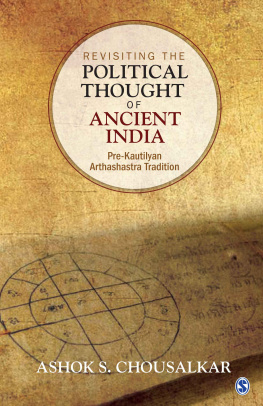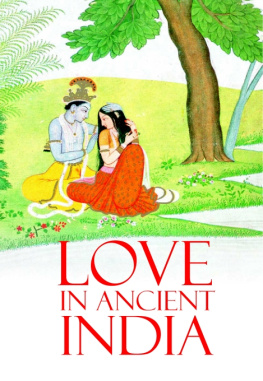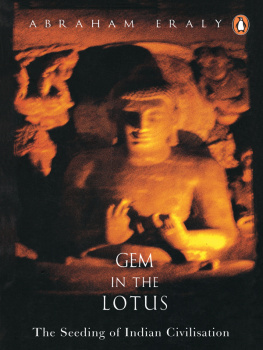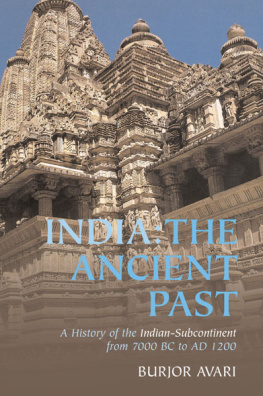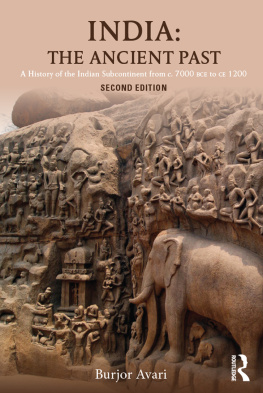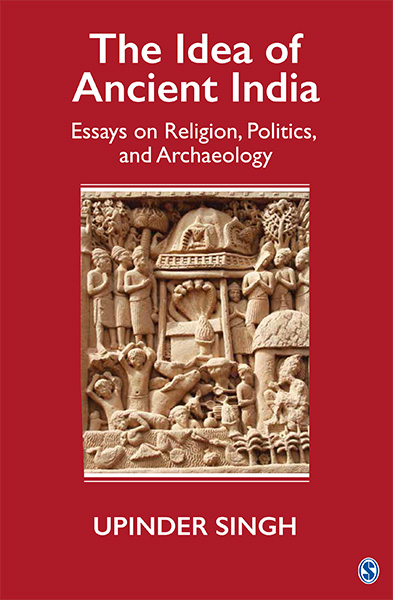The Idea of
Ancient India
The Idea of
Ancient India
Essays on Religion, Politics,
and Archaeology
UPINDER SINGH

Copyright Upinder Singh, 2016
All rights reserved. No part of this book may be reproduced or utilized in any form or by any means, electronic or mechanical, including photocopying, recording or by any information storage or retrieval system, without permission in writing from the publisher.
First published in 2016 by

SAGE Publication India Pvt Ltd
B1/I-1 Mohan Cooperative Industrial Area
Mathura Road, New Delhi 110 044, India
www.sagepub.in
SAGE Publications Inc
2455 Teller Road
Thousand Oaks, California 91320, USA
SAGE Publications Ltd
1 Olivers Yard, 55 City Road
London EC1Y 1SP, United Kingdom
SAGE Publications Asia-Pacific Pte Ltd
3 Church Street
#10-04 Samsung Hub
Singapore 049483
Published by Vivek Mehra for SAGE Publications India Pvt Ltd, typeset in 10/12.5 Minion by Zaza Eunice, Hosur, India, and printed at <>.
Library of Congress Cataloging-in-Publication Data Available
Names: Singh, Upinder.
Title: The idea of ancient India : essays on religion, politics, and
archaeology / Upinder Singh.
Description: New Delhi : SAGE Publications, 2016. | Includes bibliographical
references and index.
Identifiers: LCCN 2015039148| ISBN 9789351506461 (hardback : alkaline paper)
| ISBN 9789351506478 (ebook) | ISBN 9789351506454 (ePub)
Subjects: LCSH: India--Antiquities. | Archaeology and religion--India. |
Archaeology--Political aspects--India. | India--History--To 324
B.C.--Sources. | India--History--324 B.C.-1000 A.D.--Sources. |
Buddhism--India--History. | Excavations (Archaeology)--India. | Sacred
space--India. | Inscriptions, Indic. | India--Intellectual life.
Classification: LCC DS419 .S53 2016 | DDC 934--dc23 LC record available at
http://lccn.loc.gov/2015039148
ISBN: 978-93-515-0646-1 (HB)
The SAGE Team: N. Unni Nair, Sandhya Gola, and Ritu Chopra
For
Nayanjot Lahiri, Seema Alavi, and Parul Pandya Dhar
friends and fellow historians
Contents
1.Sanchi: The History of the Patronage of an
Ancient Buddhist Establishment
3.Cults and Shrines in Early Historical Mathura
(c. 200 bc to ad 200)
5.Archaeologists and Architectural Scholars in
19th Century India
6.Amaravati: The Dismembering of the Mahacaitya
(17971886)
7.Buddhism, Archaeology, and the Nation:
Nagarjunakonda (19262006)
8.Exile and Return: The Reinvention of Buddhism and
Buddhist Sites in Modern India
9.Governing the State and the Self: Political Philosophy and
Practice in the Edicts of Asoka
11.The Power of a Poet: Kingship, Empire, and War in
Klidsas Raghuvasa
12.Gifts from Other Lands: Southeast Asian Religious
Endowments in India
13.Politics, Piety, and Patronage: The Burmese
Engagement with Bodhgay
Among historians, debates on the idea of antiquity and periodization have led to a sharp decline in the use of the adjective ancient in favour of early. I prefer to talk about ancient rather than early India, mainly for aesthetic reasons. The adjective early is bland, dull, nondescript; ancient, on the other hand, has depth, mystery, resonance. Similarly, I use the singular idea rather than ideas in the title of this book because it seems to me to possess far greater weight. Moreover, it does not exclude plurality, which is an intrinsic aspect of the past as well as of all historical interpretation. The idea of ancient India can, therefore, encompass infinite ways of understanding the ancient past of India, or rather, South Asia. This book reflects the ways in which my own thoughts on the subject have evolved and changed over the past two decades.
My initial writing belongs to the long period of time I taught at St Stephens College. Although I wrote three books over those years, the combined pressure of undergraduate teaching and family responsibilities meant that time for research and writing was scarce; it had to be created with considerable difficulty and struggle. Moving to the History Department of the University of Delhi in 2004 was an exhilarating experiencefor the first time, I had enough time to read, think, and write and also the opportunity to incorporate my research into teaching. Most of the chapters in this book were written after I joined the University Department.
Although these chapters cover many of my interests, some were left out, and at least two of them are important. The first is the village-to-village survey that I conducted in 19941995 along with my friend and colleague Nayanjot Lahiri (Tarika Oberoi joined us subsequently) in Faridabad district in Haryana. This project sensitized me to the importance of the materiality of Indias ancient past and how it lives on, incorporated but transformed in meaning, in contemporary villages. two challengesto construct a continuous narrative of Delhis ancient past on the basis of very meagre sources, and to write in a style accessible to the general reader. The second was much more difficult than the first. My work on Delhi was accompanied by a conviction that exposing students to local history was one of the best ways of generating an interest in the discipline of history in their minds. This led to the idea of introducing a series of courses on Delhis history in the undergraduate programme of the University of Delhi.
Religion and Region
The chapters in the first section of this book reflect my enduring interest in analyzing epigraphic data and situating inscriptions within their larger contexts. The approach is strongly empirical, not only because the minutiae of details have always attracted me but also because I think that historical hypotheses must be very thoroughly grounded in the empirical data and very carefully calibrated with regard to chronology. Many of the inscriptions I studied were associated with religious sites. My interest in religion was in large measure an instinctive one, but was also influenced by dissatisfaction with the manner in which Indian historians of the 1970s and early 1980s tended either to sideline this important aspect of history or to reduce it to legitimation strategy.
Sanchi: The History of the Patronage of an Ancient Buddhist Establishment (Chapter 1) was the first paper I wrote after completing my PhD. I visualized it as part of a larger project on the inscriptions of early Buddhist sites in India. The chapter offers a diachronic view of the patronage of Sanchi, bringing out the elements of continuity and change over five phases, beginning with Asoka in the 3rd century bce and ending in the 12th century. The epigraphic data from this site was very amenable to statistical analysis, but I also thought it could be fruitfully juxtaposed with textual, sculptural, and archaeological evidence.
Between the 2nd century bce and the 1st century ce , there was a massive upsurge of popular support for Buddhism all over the subcontinent, of a kind never seen before or since. At Sanchi, this period saw busy construction activity, especially the building of stupa s, and the engraving of over 800 donative inscriptions.
The chapter begins with a cautious disclaimer, stating that it does not aim at adding to knowledge about the theoretical aspects of patronage. But in retrospect, I think that it does. It situates donative inscriptions and their empirical content within their larger archaeological and artistic contexts. It compares textual precepts with monastic and lay practice.




